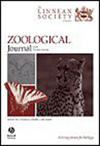Phylogeny, biogeography, and diversification of the cicada Pomponia linearis and its allies (Hemiptera: Cicadidae)
IF 2.8
2区 生物学
Q1 ZOOLOGY
引用次数: 0
Abstract
The taxonomically chaotic Asian genus Pomponia is one of the more species-rich genera in Cicadidae, with multiple species groups and species complexes. To help understand the evolution of Pomponia, establish a time frame, and define species, we studied morphology and conducted molecular phylogenetic and phylogeographical analyses of 394 individuals belonging to the Pomponia linearis species group and relatives using five or six genes, respectively. The most widely distributed species of Pomponia is confirmed to be P. linearis; Pomponia yayeyamanasyn. n. is recognized to be a junior synonym of P. linearis; Pomponia backanensissyn. n. is recognized to be a junior synonym of Pomponia subtilita; and six species are new to science. The phylogeny of Pomponia and related genera does not support the monophyly of Psithyristriini. The ancestor of the P. linearis species group is presumed to have originated from Hengduan Mountains and Yunnan–Guizhou Plateau at ~5.41 Mya and initially diversified during the Mid-Pliocene to Early Pleistocene. P. linearis comprises five subclades corresponding to geographically isolated populations. Dramatic Pleistocene climatic oscillations and niche vicariance were presumably the main drivers for the diversification of P. linearis and allies. This study improves understanding of the diversification, phylogeny, and dispersal history of cicadas in Eastern Asia.蝉 Pomponia linearis 及其同类(半翅目:蝉科)的系统发育、生物地理学和多样性
分类混乱的亚洲鲳属是蝉科中物种较丰富的属之一,有多个种群和种群复合体。为了帮助了解 Pomponia 的进化、建立时间框架和定义物种,我们对属于 Pomponia linearis 种群和近缘种的 394 个个体进行了形态学研究,并分别使用 5 或 6 个基因进行了分子系统发育和系统地理学分析。确认了分布最广的 Pomponia 物种为 P. linearis;Pomponia yayeyamanasyn.Pomponia 和相关属的系统发育不支持 Psithyristriini 的单系。据推测,P. linearis种群的祖先起源于横断山脉和云贵高原,时间约为5.41 Mya,在中更新世至早更新世期间初步分化。P.linearis由五个亚支系组成,与地理上孤立的种群相对应。据推测,剧烈的更新世气候振荡和生态位沧海桑田是P. linearis及其同属物种多样化的主要驱动力。这项研究加深了对东亚蝉的多样性、系统发育和扩散历史的了解。
本文章由计算机程序翻译,如有差异,请以英文原文为准。
求助全文
约1分钟内获得全文
求助全文
来源期刊
CiteScore
6.50
自引率
10.70%
发文量
116
审稿时长
6-12 weeks
期刊介绍:
The Zoological Journal of the Linnean Society publishes papers on systematic and evolutionary zoology and comparative, functional and other studies where relevant to these areas. Studies of extinct as well as living animals are included. Reviews are also published; these may be invited by the Editorial Board, but uninvited reviews may also be considered. The Zoological Journal also has a wide circulation amongst zoologists and although narrowly specialized papers are not excluded, potential authors should bear that readership in mind.

 求助内容:
求助内容: 应助结果提醒方式:
应助结果提醒方式:


